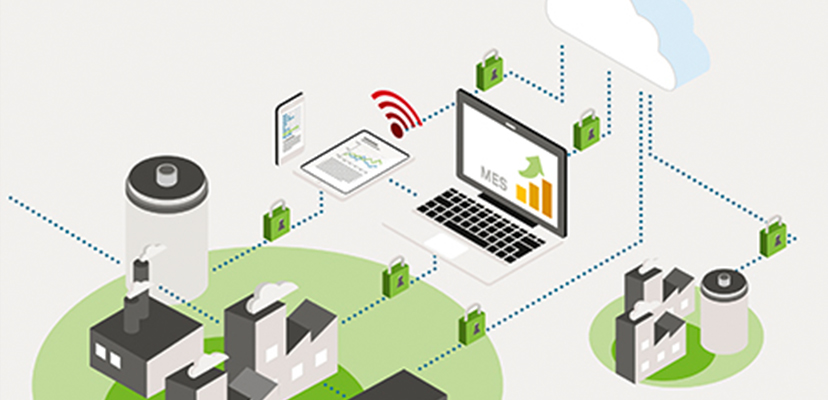


The networked, intelligent, self-controlling, self-optimizing, and resource-efficient production is the central scenario of Industry 4.0 – the Smart Factory. Despite the alleged advantages that Industry 4.0 production appears to offer, questions remain for many companies, such as: why is it even necessary? what level of their own production must attain 4.0? and what steps should be the first on their path to the Smart Factory?
It is undeniable that an intelligent, resourceefficient, and cost-efficient production is gaining significance against a background of increasing international competition. The advantages of Industry 4.0 will therefore produce results primarily in the future, and will determine the future of the production facility in Germany. Because Germany is still a country with high labor costs. Labor costs are now, as previously, over-proportionally high in comparison with abroad. Because the Federal Republic is among the leading global countries with respect to the proportion of GDP in industrial production, there are significant efforts to reinforce production operations using a maximum level of automation. And due to the increasing level of automation, modern infrastructure, IT expertise, and proximity to regional markets, companies are beginning to relocate their labor-intensive production back to Germany. In this context, there are those in industry who are already talking about a re-industrialization, similar to that occurring in the USA. The fact is that industrial production is one of the pillars supporting the German economy, and should remain so into the future.
Individual Ideas for Tomorrow’s Production
However, in order for Germany to remain an attractive location for manufacturing companies, these corporations must also be in a position to manufacture profitably, even in the context of individualization and globalization. The ability to manufacture products according to lot size 1 without substantially increasing production costs will be an indicator for the Smart Factory for companies. The future success of producing companies will be determined by their production changeability and the ability to network to a high degree along the entire value chain – right up to the end product. How this will be specifically implemented in production essentially depends on the existing underlying conditions. The Smart Factory cannot be imposed as a solution; instead, the smart version of an extant production line must be as individual at the processes of the producing company itself.
Before considering how Industry 4.0 can be technologically introduced into existing production, there must be consideration as to which ideas, methods, or approaches can lead to an improvement in the existing individual production processes. These improvements may lie in more efficient use of resources during production, preventing duplication of applications along the value-added chain, or significantly shortening system engineering times. For example, there are potential advantages for machine and system designers in observing a system after the sale and obtaining as much data from the life cycle as possible, which would allow them to draw conclusions to apply to refinements in their own work, or would enable them to provide recommendations to their clients about operating the machines.
Measure First, Then Manage
No matter which method is applied for transitioning from the merely extant to the Smart Factory, networking of existing processes and operations remains a prerequisite. This networking includes the vertical, namely from the control system to the field level, as well as the horizontal, which extends beyond the various steps in the value-added chain. The only opposition to this type of complete networking today is that the data cannot be consistently generated and used. Diverse media and system discontinuities, which occur in both the vertical, but primarily in the horizontal integration, introduce difficulties in correlating data logically and sensibly across processes. As a rule, each Industry 4.0 approach initially proposes recording data, digitizing them, and linking them to one another in a profitable way. This step is precisely the central thought driving Industry 4.0: collecting, networking, and evaluating data from the production process in order to exploit them profitably such that a sustainable added-value is generated for the corporation.
Data Transparency for the Smart Factory
The essential criteria, which characterize a Smart Factory, are those that enable the measuring, networking, and evaluation of data:
The first step along this path is transparency across all production- and system data. Only when the data have been brought into context with one another, suitably processed, and consolidated into information, can measures be introduced to improve the production process. For this to succeed, sensors must record product- and production-relevant data at the field level. These sensors have to be considered in the system architecture or incorporated into the product itself, for example, in the form of RFID chips. With regard to production-relevant data, which is recorded via sensors on the machines and systems, the challenge consists less in the mere collection of data, but instead in bringing the data securely and error-free from the field level into a higher level, for example, a MES (manufacturing execution system) or the cloud. So how does this work?
Automation solutions can provide a decisive contribution, like the modular WAGO-I/O-SYSTEM 750, which, with more than 500 different modules, can offer a suitable solution for practically any application area. Thus, signals can always be reliably collected from the field level and further processed. When supplemented by the PFC Controller family from WAGO, different interfaces and fieldbuses can be used, independent of manufacturer, like CANopen, PROFIBUS DP, DeviceNet, and Modbus-TCP. The WAGO controllers can also be incorporated into already existing automation systems as scalable nodes and gateways, which can be retrofitted without having to interfere with the actual automation process; the data can then recorded in parallel and transmitted to a higher level, an MES or the cloud. In this context, the advantages connected with a cloud link initially appear quite promising: cloud solutions are flexible, scalable, are highly available, and provide the opportunity for centralized access. They can also be used to comfortably manage large quantities of data. That the cloud has gained less acceptance in Germany than might have been expected appears to be based on opinions regarding IT security and the protection of proprietary knowledge; these are critical considerations about the cloud and whether companies should provide or withhold important business data. And rightly so! Those who want to use the advantages of the cloud must also consider the measures that must be undertaken in terms of IT security. Extant security mechanisms do not provide sufficient protection for the transportation of digital data from the field level to the cloud. And this is not simply because a cloud connection bypasses most security mechanisms that have already been established – in the sense of a defense in depth solution: access controls, authorization concepts, and firewalls among them.
Flexible and Safe
What is required to transport data from the field level to the cloud are so-called “IT security by design” solutions. Examples include hardware and software, which are programmed from the outset to transmit data in an encrypted manner and to prevent external access. With the PFC Controllers, WAGO provides a controller which is already several steps beyond this point, because the PFC family of controllers already possess comprehensive onboard security mechanisms for the secure transmission of data. Thus, data can already be encrypted and secured, for example, by using SSL/TLS 1.2 (Secure Sockets Layer/Transport Layer Security) encryption. Secure connections are established via a “virtual private network” or VPN. All controllers in the PFC family have these functions. Secure connections can be established directly from the controller via IPsec or OpenVPN. In addition, the controllers also have a configurable firewall. An upstream router or PC is thus no longer required, which saves costs and administrative expense. Thus, WAGO already fulfills all relevant guidelines in IT security and in a position to satisfy the requirements from the BDEW white paper for applications in the “critical infrastructure” sectors.
Creating Added Value
In order that one does not drown in the resulting data flow, applications for data analysis place a decisive role. If they are incorporated correctly and make use of the individually relevant key performance indicators (KPIs), then the existing process can be fundamentally improved, depending on where one places the focus, i.e., time, resources, or energy. More is thus accomplished on the road to a Smart Factory than a single step.
Text: Ulrich Hempen, Thomas Holm, Nils Wigger, WAGO
Photo: Fotolia.com, iStock.com, WAGO